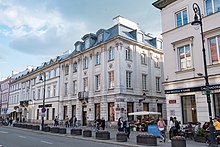Warsaw
- Wɔatwerɛ nsɛm wei ɛwɔ Asante kasa mu
Warszawa[1] yε kuro titiriw a ɛwɔ Poland. Warszawa ɛyɛ Polandi ahenkuro a emu nipa ɛyɛ opipipi 1.729.119.




Warsaw (Polish: Warszawa [varˈʂa.va] (listen)), mmara mu no Warsaw yɛ ahenkuro,[2][3] na ɛno ne kuro a ɛso yie pa ara wɔ Poland man no mu. ɛyɛ metropolis a ɛda asubɔntene Vistula so wɔ Poland apuiɛ-mfimfin mantam (east-central ) no mu na nnipa a wɔtete kuro no mu no wode w'ani bubu a wɔn dodoɔ bɛyɛ Ɔpepepem baako ne akyire pɔ nwɔtwe (1.8 million), a wɔn nyinaa wotete greater metropolitan fa mu hɔ no nso bɛyɛ Ɔpepepem mmiensa ne akyire pɔ baako (3.1 million)[4], a yei ma Warsaw kuro no bɛyɛ ahenkuro a ɛtɔ so nson a ɛmu nnipa dɔɔ so yie pa ara wɔ European Union.

Toponymy ne Edin ahodoɔ
sesaWarsaw din ankasa wɔ Polish kasa mu ne Warszawa. Nkane no edin ahodoɔ a na nka wɔde frɛ kuro yi ne sɛdeɛ na wɔtwerɛ no no bi ne Warszewa, Warszowa, Worszewa anaa Werszewa[5][6]. Edin yi abɔseɛ anaa baabi korɔ pɔtee a wɔnyaa saa edin yi firiiɛ deɛ, obiara nnim de bɛsi nnɛ.[7][8] Nkane no, na Warszawa yɛ din a wɔde frɛ namyifoɔ beaeɛ bi a na ɛwɔ asubɔntene Vistula ano pɛɛ[9].
Ɔsom ahodoɔ
sesaƐfiri mmerɛ a wɔkyekyeree kuro a yɛfrɛ no sɛ Warsaw no asom ahodoɔ beberee na wɔdi wɔn dwumadie wɔ hɔ ɛno nti ama kuro no ayɛ kuro a amammerɛ ahodoɔ ne ɔsom ahodoɔ adi afra.[10] Afe apem ahankron ne baako nnipa ne adan akenkan (1901 census) dwumadie no kyerɛɛ sɛ, nnipa a wɔtete kuro no mu no dodoɔ yɛ 711,988 na ɛmu ɔha mu nkyekyɛmu 56.2% na wɔkɔ Catholic asɔre no bi, ɛmu ɔha mu nkyekyɛ mu 35.7% nso yɛ Jewfoɔ, ɛmu ɔha mu nkyekyɛmu 5% nso yɛ Greek Orthodox akristofoɔ ɛna ɛmu ɔha mu nkyekyɛmu 2.8% nso yɛ Protestantfoɔ.[11] Mfie nwɔtwe akyi wɔ afe 1909 mu no,Jewsfoɔ no dodoɔ no kɔduruu 281,754 a ɛgyina hɔ ma ɔha mu nkyekyɛmu (36.9%), Protestantfoɔ no nso dodoɔ no kɔduruu 18,189 a ɛgyina hɔ ma ɔha mu nkyekyɛmu (2.4%) ɛna na nnipa no mu 2,818 nso yɛ Mariavites foɔ a wɔn dodoɔ no gyina hɔ ma ɔha mu nkyekyɛmu (0.4%).[12] Yei nam so maa wɔsisii hyiadan ahodoɔ bɛboro ɔha ne akyire ne twaa kuro no mu nyinaa hyiaeɛ.
Mfonin ahodoɔ
sesa- Headquarters of Polish government agencies in Warsaw
-
The Presidential Palace, seat of the Polish president
-
The seat of the administration of the Masovian Voivodeship
-
Mostowski Palace, the seat of Warsaw's police headquarters
-
The main gate of the Ministry of Health
-
Carmelite Church has an original 18th-century façade
-
Wilanów Palace, once a royal residence
-
Belweder Palace, official seat of the President
-
Krasiński Palace, a branch of the National Library
-
Canon Square (Kanonia) with the narrowest townhouse in Europe
-
Three Crosses Square marks the entry into Old Town
-
Barbican, a remaining relic of historic fortifications.
Baabi a menyaa mmoa firiiɛ
sesa- ↑ Pronunciation: English: /ˈwɔːrsɔː/ WOR-saw Polish: Warszawa, [varˈʂava] (listen) Latin: Varsovia
- ↑ http://isap.sejm.gov.pl/isap.nsf/DocDetails.xsp?id=WDU20180001817
- ↑ https://en.wikipedia.org/wiki/Polish_language
- ↑ http://appsso.eurostat.ec.europa.eu/nui/show.do?dataset=urb_lpop1&lang=en
- ↑ Samuel Bogumił Linde, Slownik jẹzyka polskiego (1808)
- ↑ Julian Weinberg, Polacy w Rodzinie Sławian (1878)
- ↑ http://etymonline.com/index.php?allowed_in_frame=0&search=Warsaw
- ↑ http://revije.ff.uni-lj.si/linguistica/article/view/6271
- ↑ http://www.warsaw-life.com/poland/warsaw-legend
- ↑ Geert Mak (2008). In Europe: travels through the twentieth century. New York: Pantheon Books. p. 427. ISBN 978-0-307-28057-2.
Today Warsaw is a monocultural city, which is some people's ideal. But before 1939 it was a typically multicultural society. Those were the city's most productive years. We lost that multicultural character during the war.
- ↑ Hermann Julius Meyer (1909). Meyers Konversations-Lexikon (in German). Vol. 20 (6th ed.). Leipzig and Vienna. p. 388.
- ↑ Erich Zechlin (1916). Die Bevölkerungs- und Grundbesitzverteilung im Zartum Polen [The distribution of population and property in tsaristic Poland] (in German). Berlin: Reimer. pp. 82–83.